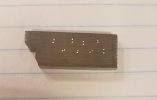Ok I have an update. I was able to get one on the chuck and prep both sides. For a reference we don’t leave scale on the back side of blades before testing. We use a scraper if it does not pop off in the quench.
I took the top surface down till the test groove and test dimples where removed. I’m guessing it was about .020. But I snapped a few pictures while grinding because the sparks coming off the grinder looked really good. I have had some that sparked like mild steel. Come to find out it was and was sold to him as high carbon on eBay. So I worked my way through the grits up to a norax 5x which is 3000grit. Once I got up to the norax 45 I found that I could start to see patches showing up. I have seen this before on some steel that was sent to me in the past so I’m not Surprised at all. I guessed from the beginning that it was full of soft spots. Here are the pictures
This is the first pass taking off about .005
The next pass I snagged a close up shot of the sparks.
The patches and vertical bands are clearly visible in person but harder to catch on camera because it’s so damn shiny. Took it out side to get better lighting.
we then took it inside and ran it through the demagnatizer and tested it.
you can see the tests change when going from a dark to a light spot. On the tang where I had ground and tested before I got 37.5 now. Before all this, that spot measured 37rc. So I do not find any fault with my current testing and prep procedures. Here is a picture of the blade before all this grinding.
here is a quick video showing the final grind and just how polished that surface is.












